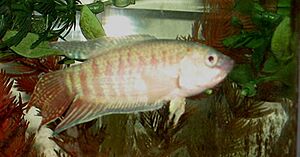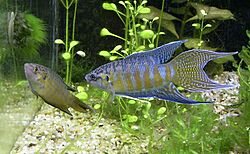Paradise fish facts for kids
Quick facts for kids Paradise fish |
|
|---|---|
 |
|
| Macropodus opercularis male | |
| Conservation status | |
| Scientific classification | |
 |
|
| Synonyms | |
The paradise fish (Macropodus opercularis), also known as the paradise gourami, is a cool and interesting type of gourami fish. You can find them in fresh waters across East Asia, from China all the way to northern Vietnam. These fish usually grow to be about 5.5 centimeters (2.2 inches) long, but some can reach up to 6.7 centimeters (2.6 inches).
Paradise fish were among the very first ornamental fish brought to the Western world for aquariums. They arrived in France in 1869, thanks to a French fish importer named Pierre Carbonnier. These fish are known for being quite feisty compared to other fish in their family. They are more aggressive than the three spot gourami but less so than the combtail.
Contents
Paradise Fish Behavior

Paradise fish can be quite combative, especially with each other. They might even attack or kill smaller fish. When they fight, their colors often change, showing dark blue stripes on their sides. They also spread out their fins and gill covers (called operculum).
These fish tend to be more aggressive towards other paradise fish than towards different species. Interestingly, their aggressive behavior seems to increase the further away they are from their natural home in Asia. In the wild, paradise fish are predators. They enjoy eating insects, small creatures without backbones (like worms), and baby fish (called fry).
Their popularity as pets has gone down a bit recently. This is because many other types of gouramis are now available that are much more colorful and usually less aggressive. Paradise fish are one of the few fish that can change their color to become lighter or darker depending on what's happening around them. They also seem to be able to learn by watching things carefully.
Where Paradise Fish Live and What They Eat
Paradise fish are very adaptable when it comes to water conditions. They can live in both cool and warm waters. In their natural habitat, you'll most often find them in shallow areas with lots of plants, like marshes or rice fields.
You can even keep them in outdoor ponds or simple aquariums that aren't heated. They will eat almost any food you give them. However, it's best to feed them a diet that is high in protein, rather than mostly vegetables. They also love to eat mosquito larvae, black worms, brine shrimp, and small flies.
Paradise Fish in Home Aquariums
If you keep male paradise fish, it's important to keep them separate because they will fight fiercely, even locking jaws. You can keep one male with several females, or keep a group of females together. An aquarium for paradise fish should be at least 20 US gallons (about 75 liters) for a single male. For a community tank with other fish, a 20 to 30 US gallon tank is better. The tank should have lots of plants and a good cover. You can also add bogwood and rocks.
Choosing tankmates for paradise fish needs care. Good choices include giant danios, large tetras, most smaller catfishes, and some less aggressive cichlids like firemouth cichlids. Slow-moving fish or those with long fins, such as fancy goldfish and freshwater angelfish, might get attacked by male paradise fish. Bettas and other gouramis might also be picked on because they look similar to paradise fish. Male paradise fish might even try to "court" female bettas or gouramis!
Any fish smaller than 1.8 centimeters (about 0.7 inches) might be eaten by a paradise fish. If you keep them with much larger but non-aggressive fish, like Geophagus cichlids, big Synodontis catfishes, or larger gouramis, paradise fish usually become more submissive. They won't act as aggressively as they would if they were the dominant fish in the tank. However, they can also be bullied by fish of similar size or even smaller if that fish has already claimed a territory. In such cases, they might hide and become stressed.
Paradise Fish Reproduction and Life Cycle
Like most bettas and gouramis, paradise fish have a special way of spawning. The male builds a bubble nest. This is a floating mat made of air bubbles covered in his saliva, often with bits of plants mixed in. He then tries to attract a female to his nest.
If the female likes the male, they will "embrace" in the open water. During this embrace, they release both eggs and sperm into the water. After each embrace, the male collects the fertilized eggs and spits them up into his bubble nest.
Once spawning is done, the male might become very aggressive towards the female or any other fish that comes near the new eggs or hatched fry. This is because eggs and fry are a common food source in nature. For this reason, a breeder usually moves the female to a separate tank. This helps both the female and the baby fish survive.
After the baby fish (fry) start swimming freely, the male's protective behavior calms down. At this point, the breeder removes the male to keep the fry safe. The fry are then fed tiny organisms called infusoria or newly hatched brine shrimp.
There is also an albino version of the Macropodus opercularis. Many fish keepers believe this albino type is less aggressive than the wild type. However, they are also thought to be less hardy and have more trouble with cold temperatures.




